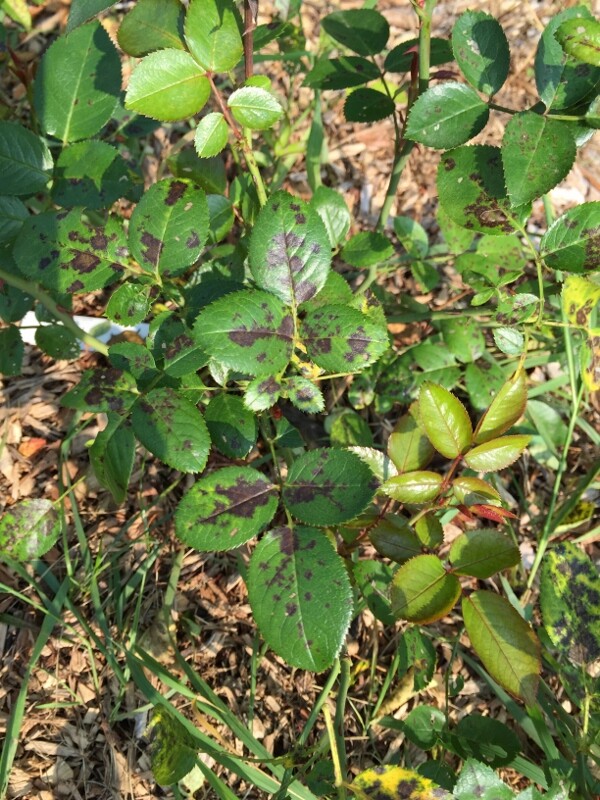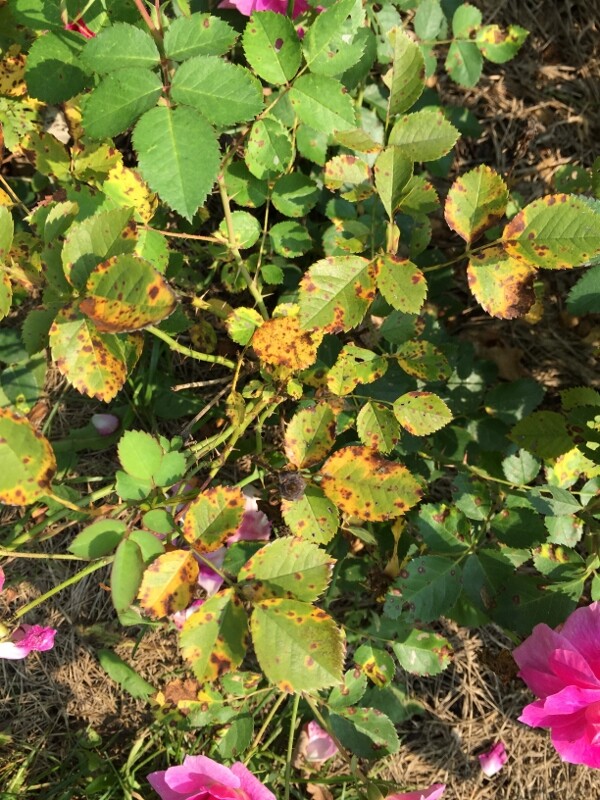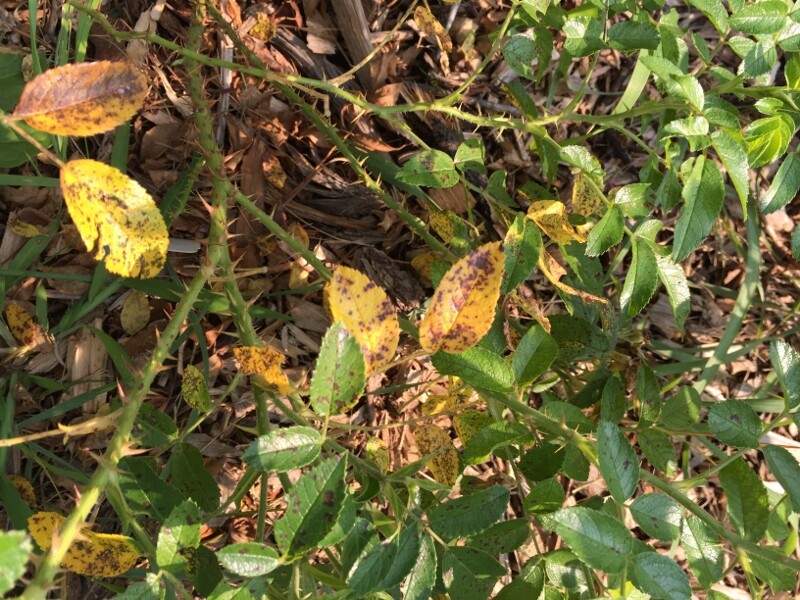In the last 13 years that I’ve lived here it has seemed like my yard is black spot central so I’ve been selecting resistant seedlings. Over the last few years rose anthracnose seems to have become a rival problem. BS resistant cultivars like Lemon Zest and Walking on Sunshine aren’t showing any BS but the leaves are highly infected with anthracnose. So this last year I started including anthracnose in my weeding out process. I’m happy to say that I have a number of seedlings this season that are resistant to both and several that are BS resistant and highly tolerant to anthracnose. Is anyone else having a problem with anthracnose?
I’ve gotten in the bad habit of lumping anthracnose visually with blackspot—I don’t really distinguish between the two. I just look at the leaf and go, “Hmm, ugly, bad.” I’ll have a closer look this morning.
Rob,
Anthracnose has been a big problem here in Minnesota and Wisconsin for the last decade. I would say it’s a bigger problem now than black spot is. Case in point; William Baffin was completely healthy for years and was a stalwart in this part of the country. Then it became highly susceptible to anthracnose where it would lose most of it leave and be bare sticks by summers end. I had two in my garden but culled them years ago for that reason. Every fall I record the extent of the diseases present on all of my roses. In my main garden last year anthracnose was present to some extent on over 90% of my roses albeit on some it was just a few lesions. Whereas BS was present on less than 10% of the roses and that’s probably because I have been pretty good at weeding out BS prone varieties but also that last year was a light year for BS here. So in my garden anthracnose is not only present but a much bigger issue than BS is. Julie Overom had an article on it in the newsletter a few years ago about how much of a problem it has become for her roses and her breeding program.
Hi Paul,
Which roses are showing better resistance to anthracnose/cercospora leaf spot for you? I’m struggling too with a lot of defoliation.
Paul,
We are having much the same issues regarding anthracnose. Thrive!, one of my healthiest has defoliated for the second year in a row. I used it as a parent this season but will end up pulling it out due to disease and limited space. The previously always healthy for me; Walking on Sunshine, Westerland, Autumn Sunset, Rugelda, Keith’s Delight Carmella Fairy Tail, Illusion and Carefree Beauty were all yanked due to complete defoliation. I thought that CB had BS issues but have since believed that it was anthracnose that caused defoliation. I purchased Lemon Zest this season and it was yanked due to severe anthracnose infection. I’ll have to see if I can find Julie’s article. Luckily I have quite a number of seedlings that so far appear to be resistant to BS and anthracnose.
David,
The modern roses that I am using as breeders, which are resistant to both BS and anthracnose are: Ruglauca, “Orange Surprise”, Raspberry Rugostar (fertile), Morning Magic, Brite Eyes, Sunny Knock Out, Quadra, Never Alone, Frontenac, Petit Pink, Therese Bugnet, Cape Diamond, Royal Edward, and Take it Easy. Those showing very good tolerance (<10% infected leaves) are: Morning Blush, Hamburger Phoenix, Eyes for You, Apricot Drift, Whimsy, Basye’s Blueberry and Pretty Lady. The latter group showed no disease at all until the end of August.
The species hybrids that I have that have excellent resistance are Corylus, Nyveldt’s White, Metis, Hazeldean, Ann Endt, OADEFED, Orantida, Tom Silvers’ “1/4 Native”, Moore’s “Golden Angel x R. soulieana”, EGS-1, and four 3rd generation R. rugosa rubra OP seedlings that are tetraploid.
I need to find a couple new breeder’s for next season to add to my stable to increase the gene pool.
Thanks for that list, Rob. It would be nice if we could compile a list of anthracnose-resistant roses from those of us who have it. (I thought it was called cercospora leaf spot??)
William Baffin is a great indicator plant that is very resistant to blackspot but defoliates from the other. I was happy to finally see my William Baffin defoliate this year so I can start breeding for resistance to lead spot.
Julie Overom has mentioned that a rose can be very healthy for years and then suddenly break down, make breeding for leaf spot resistance a frustrating task.
I’m not very good at delineating between blackspot and leaf spot, but as long as I know I have it I can still select for general health.
Hi David & Rob,
Thrive didn’t last long in my garden either I culled it after two years. CB started out very clean but over the years it has become more susceptible and I considered culling two years ago but for whatever reason decided to keep it. It’s interesting that a few of the roses that are clean for you Rob are not for me and vice versa. Keith’s Delight was very clean every year whereas Metis can be quite susceptible here depending on the year. Looking over my records from the past few years here are some of the plants that have been consistently 10% infected or less. The Rugosas with the exception of Rosalina which is quite susceptible to it. Some named varieties include: Belinda’s Dream, Carefree Sunshine, Centennial Rose, Champlain, Double Knock, Lilian Austin, My Hero, Petit Pink, Prairie Joy and Yellow Brick Road. Some of my seedlings include: (Marie Pavie x R.blanda), (My Hero x 1B30), (Folksinger x 1T20), (7A89 x Frontenac) and (Belle de Crecy x Frontenac).
David I meant to add that Ark-1, Ark OP and 3H130 were consistently clean also.
Hi- thanks Paul for sharing your resistant parent stock. I went and had a look and as far as my eye can discern, no sign of anthracnose here, in a year that has been quite bad for blackspot. Tatton broke down completely this year, and has been bullet-proof in the past. My own Easy Going x Bonica has had not a single trace of black spot, though it has had some powdery mildew. I will keep using Easy Going as a seed parent on the theory that it passes on both yellow and BS resistance, which it appears to so far.
Total defoliations this year: Tatton, Precious Dream, Hot Tamale, Morden Sunrise, Morden Centennial and Winnipeg Parks (though the latter two recovered). Decent partial resistance to BS: my own Carefree Delight OP. Full resistance: Easy Going, Lion’s Rose, Garden Delight and EaGo x Boni.
Over in the Stanley Park rose garden, most of the Kordes roses performed very well, though Floral Fairy Tale seems to get a nasty rust. Poseidon was new there this year and theres not a trace of disease on it. Anna’s Promise (Carruth) is another new one there- it’s exceptionally healthy, compact (so far) and quite beautiful.
We had a very dry, sunny summer here.
don
Thank you all for your input. This is a big problem in my area and your contributions are appreciated. In addition to listing what cultivars are subject to anthracnose in your area, it would be very helpful to have more people list what cultivars are resistant. Is there any consensus that Centennial Rose and Yellow Brick Road are resistant to both leaf spot diseases?
I forgot to mention that I have several Lemon Splash x Orantida seedings that so far are resistant to both spot diseases. These seedlings are 25% R. nitida from dad and 17% R. wichuraiana Crép. from mom. I’m hoping that resistance genes were passed on as well as smaller shrub size.
Joe,
You raise a good question for me, is it anthracnose or cerospora that is such a blight in my garden? Either one, I’ll be selecting for resistant seedlings to any kind of spots.
In the book “Roses for the North” published by the University of Minnesota they grouped anthracnose and cerospora together and just called it leaf spots so that is what I call it. Here are some pictures of black spot and leaf spot. Black spot usually is larger and the edges are less define whereas leaf spots usually are smaller with well defined edges. Also there tends to be more spots with leaf spots, I call it the shotgun affect.



Here in my middle GA garden my most spot-free (BS & cercospera) roses are Morning Magic, Miracle On The Hudson, Smiling Jean, Sophisticate, Seashell Sands, Spring Fever (the small shrub), Marinette & Ann (old Austin shrubs), Mike Shoup’s Gideon Lincecum & Roemer’s Hip Happy . . . some newly planted varieties that are looking outstanding include Watercolors Home Run, Flamingo Kolorscape, Lemon Fizz Kolorscape, Kardinal Kolorscape, and Campfire Rose.
Paul,
Thank you for posting the pictures. I definitely have both BS and leaf spots. The latter is rapidly becoming a bigger problem for me. Maybe that is because I’ve been selecting for BS resistance all along and only the last couple years for leaf spot. I just pulled Walking on Sunshine last night as it was fully covered in leaf spot with leaves dropping. Up unitl last year WOS was clean. Complete breakdown this season. Lemon Zest definitely was covered in leaf spot not BS. I was disappointed about that one as it is yellow and a diploid and I had imagined many crosses with other diploids.
Shoy,
Thank you for sharing which roses are resistant in your garden. I’ll be looking up many that you listed to see if I can use them towards my goals.
You’re welcome Rob. That’s too bad you’re seeing so much leaf spot this year. I know how frustrating that is.
One thing that Julie and I have noticed is that leaf spots get worse on a plant after two or three years from being planted or moved. I moved this spring and brought quite a few of my plants with me and I’m not seeing the level of leaf spots this year as I have in the past. But then again Julies says this has been a light year for disease for her roses. Our speculation is that anthracnose or cerospora over winter on the stems of the plants and it takes several years for it to build up on a plant. In our part of the world only the hardiest roses will have any stems survive the winter. That may explain why they seem to be the ones most affect by these diseases and the very tender roses seem to be the least affected. Several of the roses that I noted as being quite resistant to these diseases are also the most tender that die back to the ground every year; like Keith’s Delight, Belinda’s Dream and Yellow Brick Road. So take that into consideration when looking for resistant varieties.
Hi- I spoke too soon about lack of anthracnose- a closer look found it on several of my plants, Winnipeg Parks being the worst. Vancouver BC appears to be a wonderful place to live if you’re a fungal pathogen.
Thank you for the additional information Paul. Do you know if there is any visible evidence of ‘leaf spot’ on the stems? I’ve seen purple areas on stems of plants infected with some kind of fungus but was not sure which one at the time. I’m thinking it may have been BS??
Rob,
I’ve seen spots on some stems in the fall as well. My memory is escaping me now as to whether I associated those then with leaf spots or not. I’m not an expert but my guess is that they probably were.
Here is a link to a ARS page regarding diseases. It’s one of the few I found with descriptions for both anthracnose and cercospora. It mentions to remove canes with purple spots of them.
http://www.rose.org/rose-care-articles/seeing-spots-before-your-eyes/
Here is a page with good pictures of the various diseases. Based on those photos what I see on my plants is likely cercospora and not anthracnose.
http://forums.gardenweb.com/discussions/1567010/jean-tn-did-anyone-save-her-disease-pics